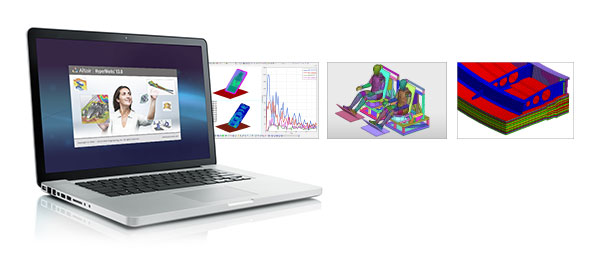|
|
|||||
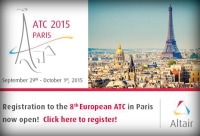
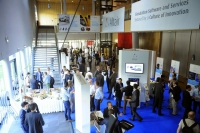
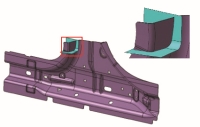
B-pillar Reinforcement CAD
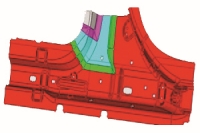

RADIOSS Scalability Study

RADIOSS Speedup Curve
Accueil > Actualités > L'Actu de Altair
Du 29 septembre au 1er octobre 2015, aura lieu, à la Cité de la musique, la 8ème édition de la conférence européenne Altair. Après plusieurs mois de travail et de concertation, nous sommes heureux de vous annoncer que l’agenda de ces 3 jours de conférence est finalisé. Au programme de ces 3 journées, entièrement tournées vers la simulation et l’innovation, 35 sessions techniques, 35 symposiums, 23 keynotes et plus de 600 spécialistes et managers attendus!
Le 29 septembre, première journée de la conférence, débutera par l’Academic User Day 2015 . Au cours de cette journée consacrée à la Recherche Appliquée dans le domaine de la simulation, plus de vingt études de cas académiques et illustrées seront présentées par des étudiants et des professeurs originaires de toute l’Europe.
Le 29 septembre, auront également lieu plusieurs séminaires techniques dont les thématiques ont trait à l’analyse de structure, la vibroacoustique, l’optimisation multidisciplinaire, la simulation système, la CFD, la modélisation et la visualisation ainsi qu’un symposium sur la simulation systèmes.
Le mercredi 30 septembre et le jeudi 1er octobre, vous aurez la possibilité d’assister à la présentation en keynotes de grands industriels : Airbus, Alstom, Ford, Hyundai Kia Motor, Jaguar Land Rover, PSA Peugeot Citroën, Renault Nissan, RUAG, STELIA Aerospace et Volkswagen.
James Scapa interviendra également pour vous présenter sa vision et sa feuille de route quant aux développements des solutions Altair.
L’automobile, la réduction des temps de développement, la fabrication additive, le ferroviaire, l’électromagnétique haute fréquence.
HP et Intel, HBM nCode, Amazon Web Serices, AlphaStar , Airbus Defence&Space, AVL, CAEfatigue, CEDREM, Componeering, Cray, FEMFAT, FluiDyna, FLUIDON, GeonX, Granta Design, Loge, Matelys, Materialise, MapleSoft, NAFEMS, NovaCast, Part Engineering, PowersSys, PDTec, Sandbox, Sidact, Software Cradle et Thermo Analytics. Enfin, pendant toute la durée de cette conférence, vous aurez le loisir de découvrir quelques-unes des réalisations auxquelles Altair a participé, notamment, la voiture de course Beta Epsilon ou encore le bras d’antenne spatial RUAG réalisé en impression 3D ! Cette conférence est entièrement gratuite mais l’inscription est obligatoire via le formulaire disponible sur notre site internet. Accédez au formulaire d’inscription. Contacts : Véronique Séverin – 0033 1 41 33 03 61- marketing-france@altair.com
|
9 decembre 2014 - Découvrez comment les solutions MATLAB permettent de répondre aux problématiques liées à la manipulation de données massives lors d’un séminaire gratuit d’une journée le 15 janvier à Paris. Au cours de ce séminaire, nous vous présenterons en matinée le workflow suivant pour analyser vos données :
L’après-midi, vous pourrez participer à un Workshop Calcul Parallèle et/ou à une Master Class Déploiement d’Applications :
|
| 19 novembre 2014 - Toward Better Failure Prediction for
Crash Simulations using HPC
PSA Peugeot Citroën collaborated with Altair, Ecole Polytechnique Laboratoire de Mécanique des Solides (LMS) and PRACE to perform a study of automotive crash rupture simulations, investigating ways to improve material failure criteria and better predict cracks. Using Curie, one of the ten most powerful supercomputer in the world, designed by the company BULL and operated by them at Très Grand Centre de Calcul du CEA (TGCC), project engineers ran huge (15M element) solid models of some component using a very fine mesh in order to simulate material failures. The massive parallelism enabled by Altair RADIOSS on the Curie system achieved unprecedented results, with levels of performance that would not have been possible on a standard computer or cluster.
The second largest carmaker in Europe, PSA Peugeot Citroën (PSA) recorded sales and revenue of €54 billion in 2013. With its world-renowned brands, DS, Peugeot and Citroën, PSA sold 2.8 million vehicles worldwide in 2013, of which 42% outside Europe. PSA is a European leader in terms of CO2 emissions, with an average of 115,9 grams of CO2/km in 2013. PSA has sales operations in 160 countries and is also involved in financing activities (Banque PSA Finance) and automotive equipment (Faurecia).
As automotive regulations impose lower and lower CO2 emission levels, manufacturers face serious challenges in decreasing design structure mass by using higher strength-to-weight ratio materials. However, introducing new materials into a design process is not a simple undertaking; design rules and numerical tools must evolve to comprehend the characteristics -- and evaluate the potential failures – of such materials. Otherwise, there is risk in delaying production awaiting reliable design direction from simulation, or (worst case) having to redesign a part late in the design cycle. In addition, due to the large, nonlinear deformations involved in simulating crash or rupture events, proper material failure criteria is essential to results accuracy. Evaluating new materials, which by definition lack the testing and refinement over time of conventional materials, also typically results in applying higher safety factors for the design which can lead to oversizing of structural parts. To improve its knowledge in assessing predictive rupture models, and to identify a viable solution for testing ruptures on a massive scale, PSA engaged with Altair through PRACE to evaluate the robustness of advanced failure criterion for steel sheets using RADIOSS, the market-leading analysis solver for crash simulation in Altair’s HyperWorks CAE software suite.
First, Altair engineers ported RADIOSS to Bullxmpi for the Curie supercomputer allocated to the study. This porting included the optimization of the setup of RADIOSS under Bullxmpi to obtain ideal performance. The efficiency of the solution based on Bullxmpi was evaluated and improved using industrial car crash models ranging from 1 to 10 million of elements. Then, two specific models were developed to study rupture of a B-pillar component with mesh size requirement of 75μm element length.
Altair had to optimize the code to handle the large simulation models, especially contact treatments inside the very fine mesh part; the project also required optimizing several I/O treatments, and engineers intensively used Intel tools like Vtune Amplifier to localize algorithms that needed to be improved. These optimizations helped Starter performance and were also useful for Engine performance related to contact sorting. In addition, Altair engineers implemented a specific material law and a rupture model in RADIOSS, which was developed through an “Industrial Fracture Consortium” including MIT, Ecole Polytechnique and industrial partners like PSA. The implementation of both law and model was validated with respect to tests on specimen and results of the original implementation by Ecole Polytechnique (LMS). Domain decomposition algorithm was tuned to optimize this material law regarding parallel efficiency.
PSA was pleased with the outcome of the study -- without access to this type of large scale supercomputer system it would have been impossible to consider running such a large simulation problem in a reasonable amount of time. Key outcomes:
The achievements obtained during this project help companies like PSA to be ready to handle increasingly complex simulations and to evaluate future needs more precisely in term of computational resources for evolving rupture simulation projects. The organizations involved plan to continue this work via a regular PRACE project to study the behavior of the rupture of this B-pillar component as well as some other components through a full vehicle crash simulation. We acknowledge PRACE for having awarded us access to resource machine Curie based in France at TGCC/CEA. |
1 septembre 2014 - Evènements ALTAIR
|
1 septembre 2014 - Formation ALTAIR
|
| 12/04/2011 - The event will take place from Nov. 7th – 9th, 2011 in Bonn, Germany and will focus on new strategies and examples of enterprise simulation methods in the development of innovative products. The European HTC conference series - now in its fifth year – has been growing from a HyperWorks user’s conference into one of the major PLM technology events in Europe, with around 500 attendees from all over the world. |
| 12/04/2011 - |
| 23/08/2010 - Altair is pleased to officially announce the date and location for the 4th European HyperWorks Technology Conference (HTC).The premier event for Driving Innovation with Enterprise Simulation will take place on October 27-29, 2010 in Versailles, France at the 'Palais de Congres' Over the past three years, Altair's Annual European HyperWorks Technology Conference has grown into one of Europe's premier PLM technology events. In 2009 our constantly growing, multi-day conference brought more than 500 industry professionals together, from a broad range of industry verticals including aerospace, automotive, consumer products, electronics, healthcare, heavy equipment, military, rail transit, ship building and white goods. The 4th European HTC will again highlight the latest trends, developments and applications in the field of enterprise computer aided engineering (CAE) and will showcase cutting-edge methods, applications and industry examples of CAE-driven innovations. The three days will be packed with valuable technical information. Just as in 2009, the event will officially be divided into two parts. On Wednesday we will offer workshops for different simulation related topics and host a variety of customer, product, and user meetings like the solidThinking day. Thursday and Friday are dedicated to our traditional conference proceedings, including a broad range of technical and keynote presentations from across industry, the meet the expert sessions, and our partner exhibition. This year's conference location is situated in the centre of France, close to Paris. Versailles is a city renowned for its chateau, the Palace of Versailles, was the de facto capital of the kingdom of France for over a century, from 1682 to 1789. It is now a wealthy suburb of Paris and remains an important administrative and judicial centre. The venue of this year's conference is full of character and located in the square of the Chateau de Versailles, in the city centre of Versailles, right across the famous castle. It offers a large exhibition space, and several prestigious auditoriums and meeting rooms for our keynote and technical sessions as well as for the diverse additional meetings. |
 |

